Almost 90% of CX leaders believe can make customer experiences better. But most haven’t rolled it out yet, and not because they don’t want to. They’re still trying to find something that’s useful, not overwhelming.
That’s why we built this guide. At Aloa, we focus on using AI to improve customer experience in ways that are practical, realistic, and built for how your team already works. Not around your workflow. Not against it. Inside it.
Here’s what you’ll walk away with:
- 7 plug-and-play AI examples your team won’t hate
- Realistic steps, from trial to scale
- Clear metrics to track and report impact
- Built-in ways to keep it human, not robotic
Let’s get started!
Understanding AI's Role in Modern Customer Service
Modern customer service is built on using AI to improve customer experience, making support faster, more personal, and easier to manage. Instead of waiting for tickets to pile up, your team can anticipate problems, offer help before it’s asked for, and personalize every interaction across channels, in real time.
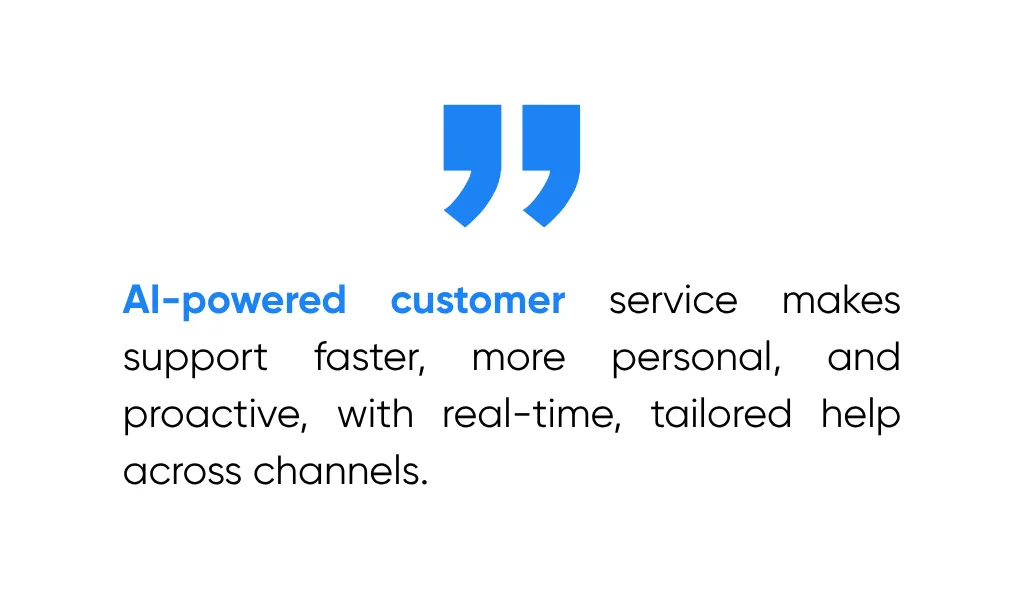
AI quietly powers that shift. It organizes messy data, flags patterns, and gives your team the context they need to respond faster (and sound like a human while doing it). When it’s working right, service feels smoother on both ends: quicker for the customer, less chaotic for your team.
Many companies already run with this:
- Pfizer helps healthcare providers flag patient risk factors earlier, so conversations at the point of care are quicker and more informed.
- CIBC tests AI tools in small pilots before rolling them out company-wide.
They treat AI like a support tool, not something that replaces their team.
But the myths still hang on. Some think AI takes over the job. Others hear “automation” and assume it means cold, impersonal service. What it really does is handle the repetitive tasks, like routing, tagging, and summarizing, so your team can spend more time doing the work only humans can do.
So how does AI improve customer experience really? Let’s break down seven ways to plug it into your existing flow.
1. Implement Intelligent Customer Journey Mapping
Old-school journey maps assume customers all follow the same linear path: Click, scroll, buy. In reality, that’s not how shoppers behave. Instead, they compare prices, read reviews, leave items in carts for days, or bounce between mobile and desktop. Static journey maps can’t capture that chaos.
AI can improve user experience by observing user behavior and adapt the system in real time.
Basically, AI-enhanced journey mapping uses predictive analytics to monitor behavior as it happens. It tracks signals like:
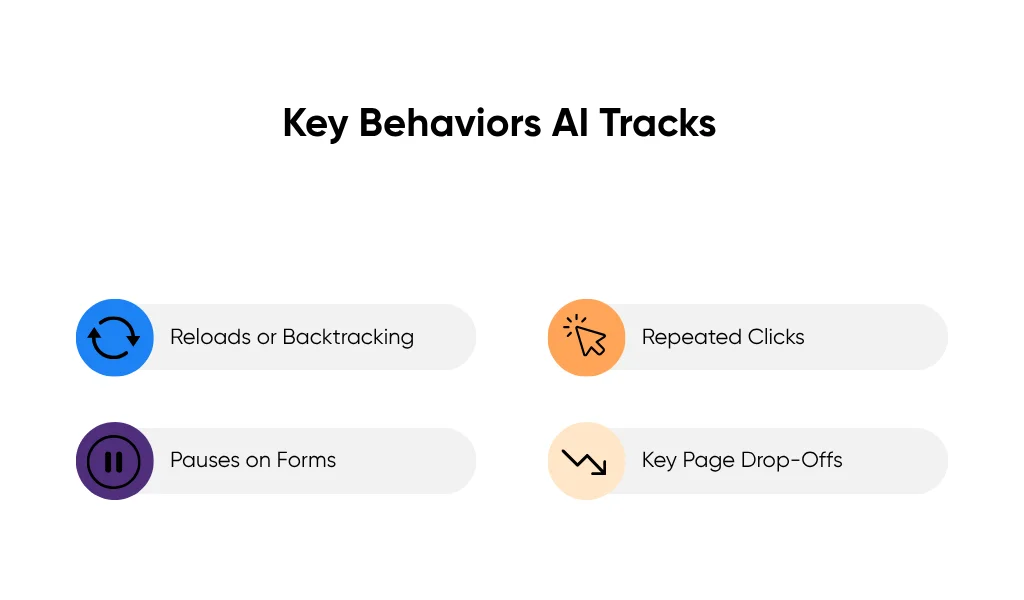
- Page reloads or backtracking
- Unusual pauses on forms
- Repeated clicks in the same spot (a sign of frustration)
- Drop-offs from key pages
Picture this: you run an online store selling smart fitness equipment. You notice that hundreds of visitors spend two to three minutes on your product detail pages, but rarely click “Add to Cart.” Traditional analytics might surface that weeks later. By then, you’ve lost dozens of potential sales.
With AI watching in real time, the system can flag users who linger too long on the specs tab and bounce right after expanding the warranty section. You dig deeper and discover the issue: your “Free 30-Day Warranty” isn’t competitive with the industry standard. Choosing to adjust that warranty offer up to 1 year can lead to your conversion rate increasing by 20-30%.
From there, real-time personalization kicks in. The system can:
- Simplify checkout flow
- Trigger live support if a user visits the contact page
- Show contextual upsells (e.g., “Pair your watch with the fitness equipment”) based on browsing behavior
This applies far beyond retail, even in complex industries like healthcare. If a patient searches for symptom-related info but doesn’t book an appointment, the system can prompt next steps, like connecting to a nurse, suggesting relevant content, or nudging toward scheduling.
Getting started looks like this:
- Timeline: A working pilot typically takes 4 to 6 weeks
- Resources: You’ll need access to behavioral user data (from your website or product), clear goals for key journeys, and a dev team to integrate the logic. If you don’t have in-house resources, our team at Aloa can build this into your current setup (no rebuild required).
When journey mapping works the way it should, you’ll see fewer drop-offs, shorter wait times, and higher conversion rates on your most important flows. Your team stops chasing symptoms after the fact and starts fixing root issues as they happen.
2. Deploy Conversational AI Solutions
Good customer service should feel like a conversation. Conversational AI uses natural language processing (NLP) to understand what customers ask, find the right answer, and reply in plain language. It goes beyond providing canned responses. They can learn from human interactions, handle follow-ups, and hand things off to agents when needed.
Platform Selection
Most teams choose between rules-based chatbots and AI-driven conversational platforms. Rules-based bots follow decision trees (fine for FAQs but useless once questions go off script). AI-driven chatbots use machine learning to understand intent and context, adapting as the conversation unfolds.
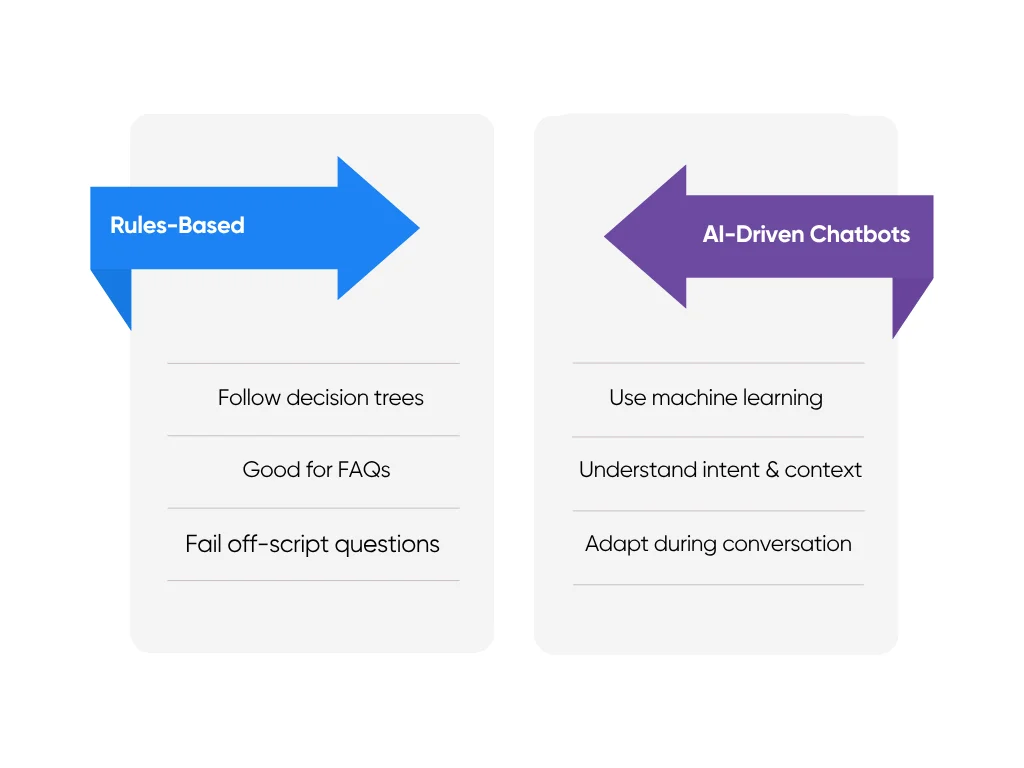
Take Mercedes-Benz, for example. Their new MBUX Virtual Assistant, powered by Google’s Automotive AI platform, blends voice, gesture, and screen input so drivers can talk naturally while the system learns tone and intent over time. It’s a smart reminder that platform choice isn’t about flashiest features. It’s about finding the system that fits how your customers already communicate.
When picking a platform, look for:
- Integration: Can it connect to your CRM, ticketing, and analytics tools?
- Scalability: Does it handle spikes in volume without breaking?
- Training Control: Can your team fine-tune how it speaks?
Cost-wise, most platforms charge per interaction or per thousand messages. For mid-sized companies, that usually means a few hundred dollars a month (far less than adding headcount).
Implementation Strategy
Rolling out conversational AI works best in phases:
- Launch with limited use cases like order tracking or appointment scheduling.
- Track metrics like resolution time, deflection rate, and customer satisfaction.
- Once the model proves itself, move into higher-value conversations like troubleshooting or renewals.
Aloa’s conversational AI development can help you clean data, clear conversation flows, and act as a technical partner who can handle the wiring. We help you design, train, and integrate custom bots that work with your existing systems.
Agent Augmentation
The best conversational AI doesn’t replace reps; it supports them. Bots handle routine customer queries, summarize interactions, and prep context before passing a ticket to a human. That means fewer back-and-forths, shorter queues, and faster resolutions.
Companies using conversational AI this way report up to 70% reductions in repetitive inquiries and 20–30% higher customer satisfaction. Customers get answers faster, customer loyalty improves, and your agents get time back to handle the conversations that matter most.
3. Leverage Predictive Analytics for Personalization
Personalization only works when it feels natural. Predictive analytics makes that possible by using data to understand what customers need before they ask. It looks at patterns in behavior and predicts what comes next, so your team can act, not react.
Data Collection Framework
AI learns from the data you already collect: purchase patterns and history, support tickets, browsing patterns, and even open-ended customer feedback. Combined, these create a live profile of customer intent. But the trick isn’t gathering more data. It’s collecting the right data and keeping it clean.
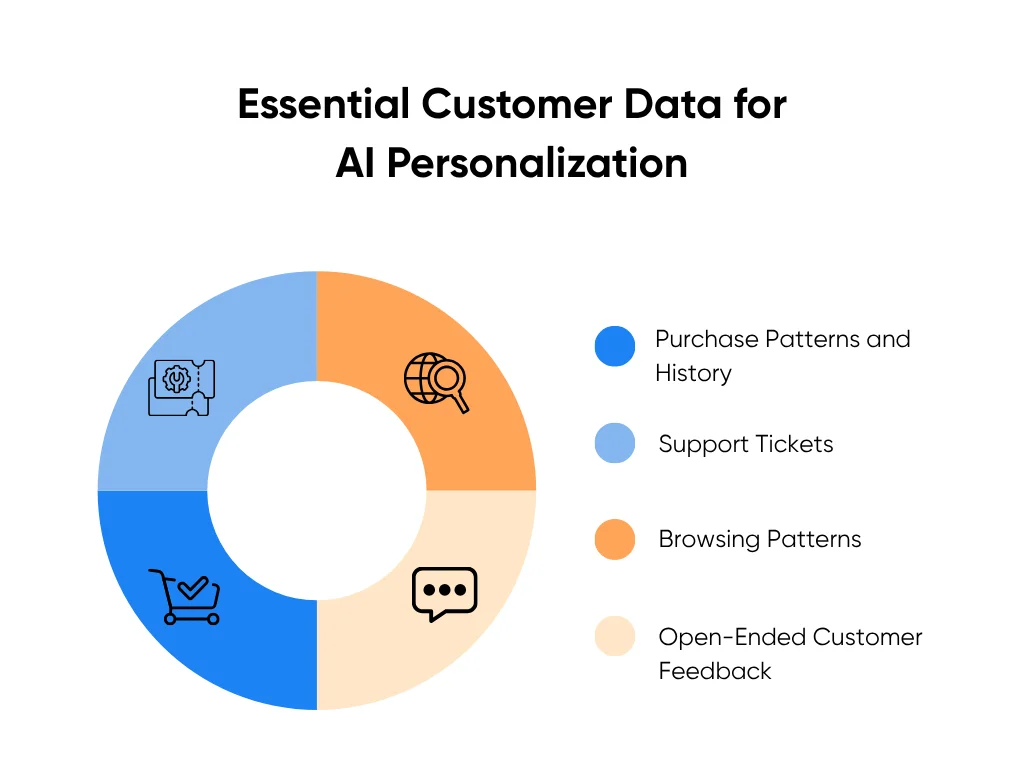
Good predictive systems connect across all your tools: CRM, email, chat, and product analytics. That way, every action adds to the bigger picture. That’s the foundation for accurate forecasting.
Segmentation Models
Once the system knows your customers, it sorts them into segments automatically. These aren’t the basic “new vs. returning” buckets. Predictive models group people by likelihood to repurchase, risk of churn, or specific needs and product interests.
For example, a healthcare platform can identify which patients are likely to skip follow-up appointments and trigger early reminders. A retail team can spot when a customer is due for a refill and send a timely nudge. Each interaction feels thoughtful because it’s based on evidence, not assumptions.
Implementation Roadmap
Here’s how to put AI personalization in motion:
- Start with what you have: Audit your customer data sources and connect them.
- Set clear outcomes: Define what success means (higher repeat sales, lower churn, faster response times).
- Build and test models: Use machine learning to forecast actions and test accuracy with a small sample.
- Launch and measure: Track lift in customer engagement, retention, and satisfaction across targeted marketing campaigns. Adjust as new data flows in.
You’ll need cross-functional collaboration: marketing for goals, data teams for quality, and technical support for integration. Aloa’s machine learning services help you design these systems to plug directly into your existing contact center stack, without heavy rebuilds or downtime.
When predictive analytics works, customers reorder sooner, support teams handle fewer repeat questions, and campaigns hit the right audience instead of getting ignored. Your data stops sitting in reports and starts driving action.
4. Enhance Voice of Customer Programs
Traditional Voice of Customer (VoC) programs rely on surveys, feedback forms, and manual review. They help, but they’re always a step behind. By the time trends surface, customers are already frustrated.
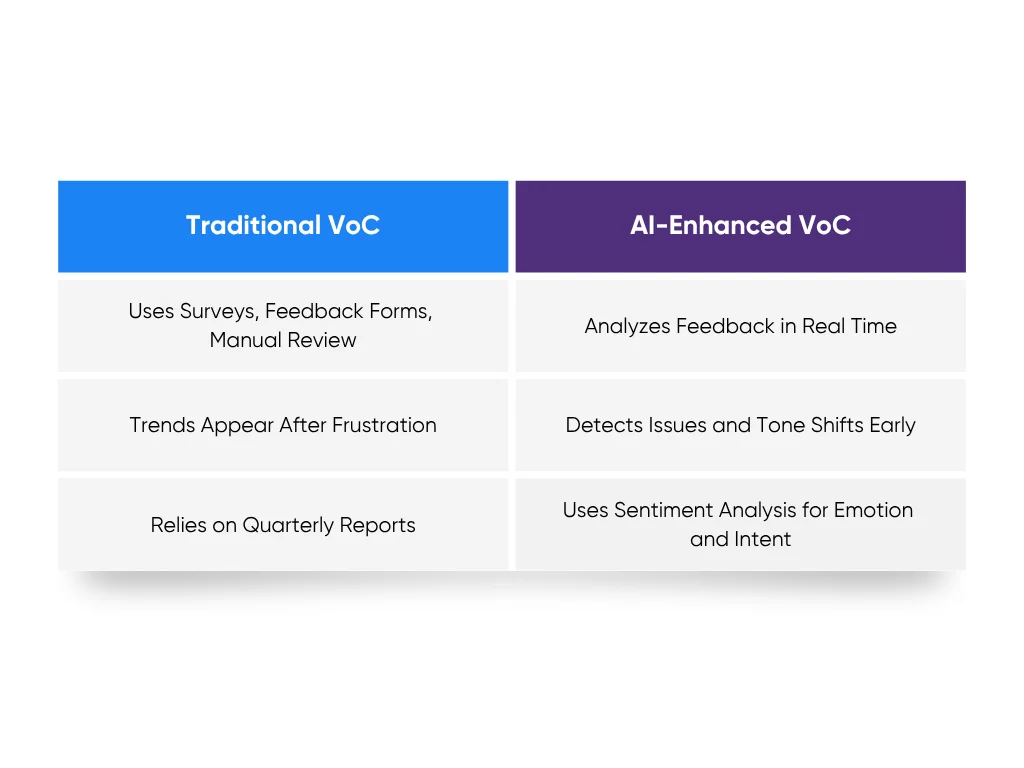
AI makes VoC smarter, faster, and more actionable. It analyzes unstructured feedback in real time, including support tickets, call transcripts, chat logs, and social media posts. Using automated sentiment analysis, the system identifies emotion, urgency, and intent. It detects emerging complaints, repeat issues, and shifts in tone before they spread. You’re not waiting on a quarterly report; you’re spotting patterns as they happen.
That’s the difference. Traditional VoC collects data. AI-enhanced VoC turns that data into alerts, trends, and next steps.
Let’s say a finance company notices a sudden rise in messages about failed transactions or delayed payments. Instead of letting those tickets pile up, AI spots the spike, tags the recurring keywords, and alerts your operations team right away. You can fix the issue or update communication before frustration spreads and satisfaction scores start to drop.
If you’re ready to stop reacting late and start acting early, here’s what you’ll need to get a basic AI-powered VoC setup off the ground:
- Timeline: 3 to 5 weeks to add AI on top of your existing VoC tools
- Resources: Centralized access to raw feedback from all customer touchpoints (chats, emails, calls), a sentiment analysis model, and a dashboard to surface the results
Once it's up and running, you’ll catch service or product issues faster, spot and resolve repeat complaints before they snowball, and drive up CSAT or NPS by addressing problems with more speed and relevance. Your team also saves hours by cutting out manual tagging and sorting.
5. Optimize Customer Support Operations
Your support team shouldn't spend hours sorting tickets, tagging the same five issues, or rewriting a refund message for the tenth time that day. AI handles the busywork, so your team can get back to resolving real problems.
Ticket Management
AI-powered ticket routing uses NLP to read what each incoming message says and decide where it should go. Instead of relying on agents to tag and assign tickets, the system spots keywords, urgency, and past customer behavior to send it to the right queue.
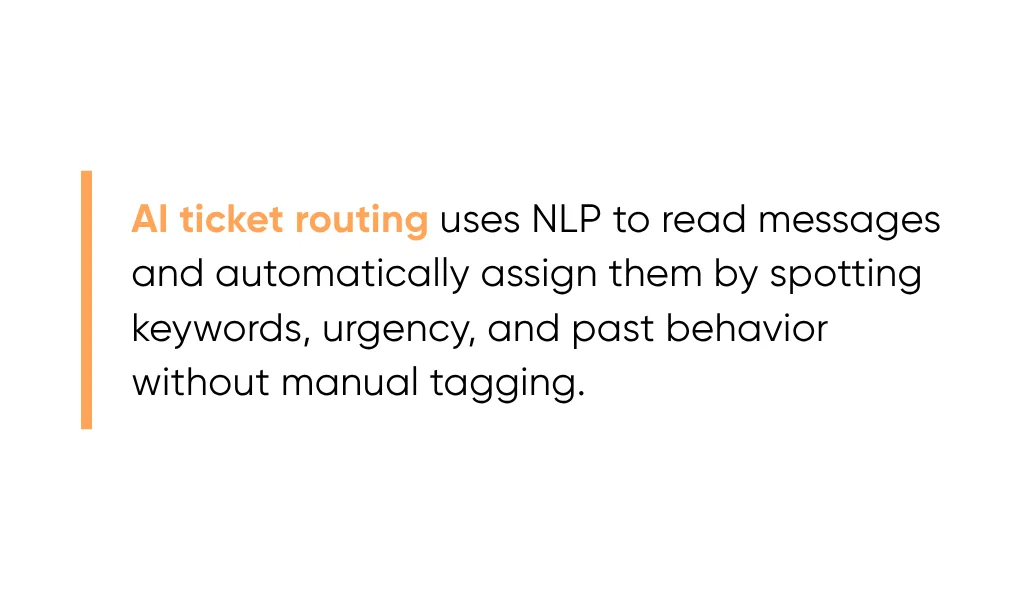
Say someone messages: “I got double charged again.” AI in customer support recognizes it’s a billing issue, marks it as high priority based on that word “again,” and routes it to the same person who fixed it last time. No one has to sort or forward anything. That’s minutes saved and friction avoided.
Teams using AI routing see fewer misrouted tickets, faster first responses, and smaller backlogs without hiring more people.
Response Automation
Once a ticket lands, AI can also draft the reply. It pulls from templates that plug in real-time info like order status, account details, or product descriptions when relevant. The agent checks the message, makes any quick edits, and sends it off.
For example:
- If a delivery’s late, the system drafts an apology and includes the updated tracking link.
- If someone requests a refund within the return window, it fills in the case ID, amount, and expected timeline.
The tone still sounds human. The agent still has control. But they’re not writing the same messages from scratch all day.
Quality Assurance
AI reviews every chat, email, or call for tone, clarity, missed steps, and policy compliance. Managers get a daily view of how agents are doing, not just a quarterly snapshot. That means you get:
- Scorecards for every interaction
- Coaching prompts based on actual examples
- Real-time alerts when something sounds cold, vague, or off-brand
This cuts down on customer complaints, speeds up onboarding, and keeps your team improving week to week.
Some teams hesitate here, worried AI means giving up control. But this gives you more visibility, not less. Every route, draft, and QA flag is based on logic you set. Now you can see what’s slowing your team down, and fix it before it turns into churn.
6. Implement Real-time Experience Monitoring
Most tools tell you what went wrong after the customer’s already left. AI gives you a shot at fixing it while it’s still happening.
Real-time experience monitoring uses machine learning to track session-level behavior: clicks, scrolls, rage-clicks, back-and-forth loops, long stalls, and sudden drop-offs. These are friction signals. Most teams don’t catch them until tickets pile up or churn creeps in. AI flags them live, spots patterns, and pushes a fix while the session is still active.
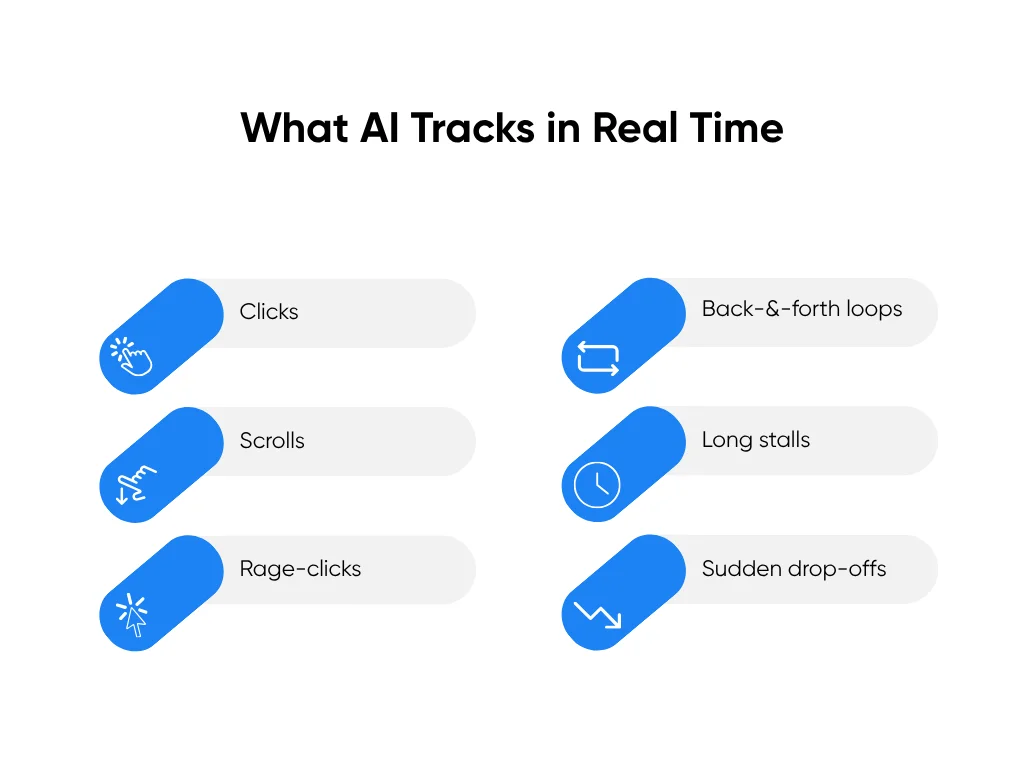
Let’s say someone bounces between your pricing and product pages without converting. The system can surface a scheduling CTA, launch a live chat, or guide them to a clearer plan comparison before they leave. You’re no longer responding after the fact. You’re helping while the experience is still recoverable.
Most teams can launch a pilot in 3–5 weeks. To get this running, you’ll need:
- Access to behavior data like clickstreams, page paths, and dwell time
- A few goal flows mapped out (signups, bookings, checkouts)
- A system that lets AI trigger real-time actions inside the experience
On the backend, most systems use clustering and anomaly detection algorithms. These models learn what a “healthy” journey looks like. Then they flag anything that deviates from it. You don't have to hardcode every possible broken flow.
Once it’s running, you’ll start seeing:
- Fewer drop-offs on high-value pages
- Quicker intervention before friction turns into churn
- Faster rollout of fixes that would’ve taken weeks to catch manually
That’s the real upside: customers get where they’re going with fewer roadblocks, and your team doesn’t have to wait for complaints to know something’s broken.
7. Develop AI-Powered Customer Insights
AI-powered insights go beyond tracking clicks or NPS scores to drive data analytics your team can act on. They use pattern recognition and clustering: two types of machine learning that spot behavior trends hiding in your raw data. Instead of looking at “how many people left,” you start seeing why they left, when they left, and who’s likely to leave next.
It starts with the signals already in your system:
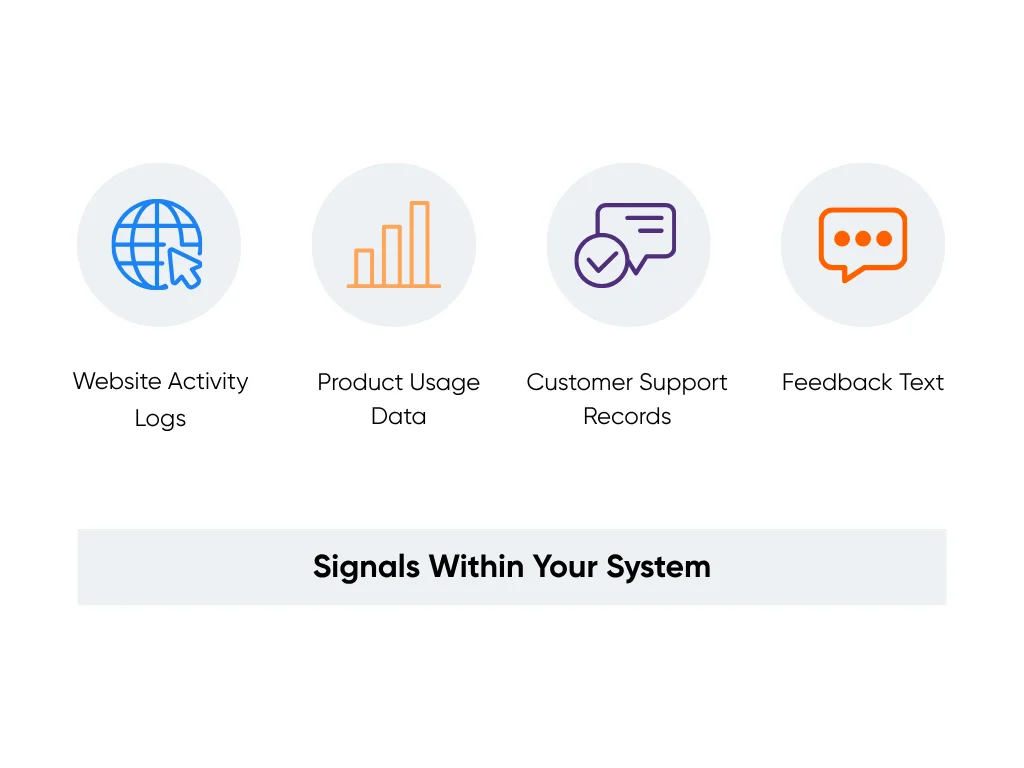
- Website activity logs (pages visited, scroll depth, click sequences)
- Product usage data (feature adoption, repeat actions, time to completion)
- Customer support records (common complaints, ticket timing, resolution paths)
- Feedback text (survey comments, review language, social mentions)
AI scans those signals and groups customers with similar behaviors: people who stall during onboarding, power users who might upgrade, or accounts that look ready to churn. These “insight clusters” form automatically, based on what users do, unlike static demographics.
For example, you notice two hundred users visiting the refund and pricing pages multiple times a week. AI flags that as a churn-risk cluster. Instead of waiting for cancellations, your system alerts the retention team, which triggers a targeted offer or a proactive check-in.
To set this up, you’ll need:
- Clean, unified behavioral data from your analytics and support tools
- A clustering or anomaly detection model trained to recognize outliers
- A dashboard or alert feed that routes insights to the right team
You can usually see clear results within 3–4 weeks. Product decisions align with real behavior. Marketing focuses on high-intent customers. Support spots risks before they become complaints. AI doesn’t replace your gut; it gives it better evidence.
Key Takeaways
You’ve got seven AI use cases your team can roll out without pausing operations or buying into bloated tools. Here’s what to do next:
- Pick one problem: slow replies, dropped journeys, repeat tickets
- Plug in the AI solution mapped to it
- Measure impact: resolution time, deflection rate, conversions
- Keep what works. Scrap what doesn’t. Repeat.
If you need help using AI to improve customer experience, Aloa builds practical tools that fit inside your current system, work alongside your team, and move fast. Start building with us.
FAQs
What’s the most useful way to apply AI to customer experience in 2025?
Start with the biggest bottlenecks: slow replies, high ticket volumes, and clunky handoffs. The most effective AI use cases solve those without overcomplicating your stack. That includes:
- Conversational AI (chatbots that actually help, not just ask for your email)
- Predictive analytics that surface intent and churn risk
- Sentiment analysis across all channels (yes, even that angry tweet)
- Smart routing that gets customers to the right person or answer faster
- Automated responses that pull from real data, not just canned lines
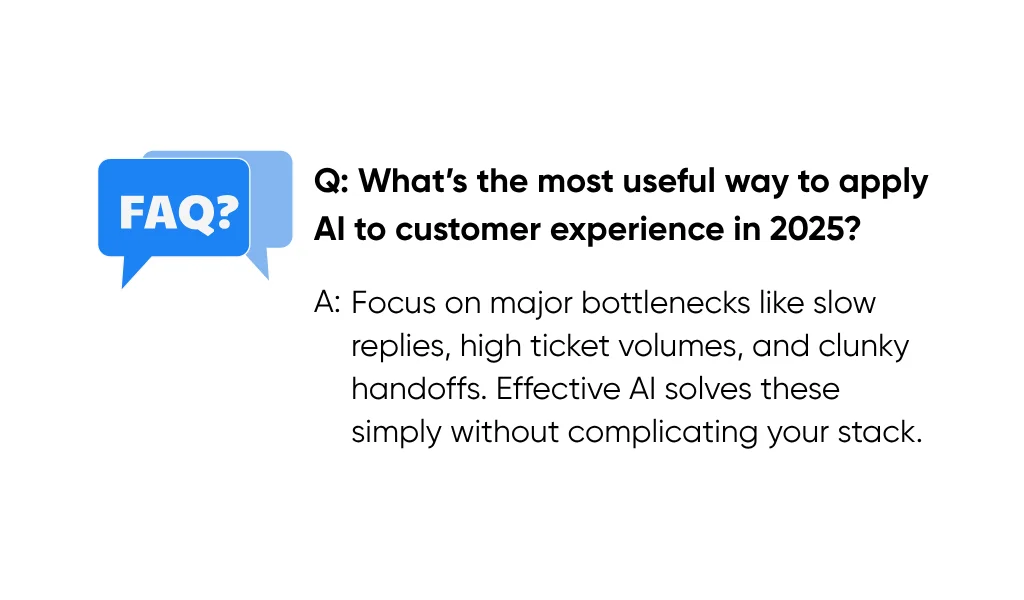
These work better together than in silos. Layering them creates an experience that feels connected, not cobbled together.
How long does it take to roll this out?
It depends on what you’re building and where you’re starting from.
- A simple chatbot? 2–4 months from planning to live.
- A full conversational AI platform with integration and training? 4–8 months.
- Predictive analytics? Around 6–12 months to get enough clean data and train reliable models.
- A full-stack AI CX overhaul? 12–24 months, typically in phases.
Most teams start with a small pilot that proves the benefits of AI within 90 days, then expand. If you want help finding the right entry point, Aloa can help you scope and build it based on what you already have.
How do we keep AI systems running well after launch?
Don’t treat it like a “set it and forget it” tool. AI systems need regular upkeep. That includes:
- Monitoring performance metrics (accuracy, CSAT, resolution times)
- Updating training data as your product or policies change
- Reviewing flagged conversations to catch new patterns
- Retraining models on fresh interaction data
- A/B testing new workflows to keep improving
Plan to invest around 15–25% of your original build cost each year in maintenance and tuning. The teams that get the most out of AI treat it like a living system, not a one-time install.
Should we build AI in-house or bring in a partner?
There’s no one-size-fits-all answer. But here’s a rule of thumb: If you’ve got a strong AI team, solid infrastructure, and time to build, go in-house. If you want to move faster or need help getting from idea to execution, start with a partner. The best setup? A hybrid approach. Use external AI platforms (like NLP or chat tools), work with a partner like Aloa to build and integrate, and build internal muscle to maintain and evolve over time.
The key is momentum. You don’t have to do it all on your own, but you do need to get started.

